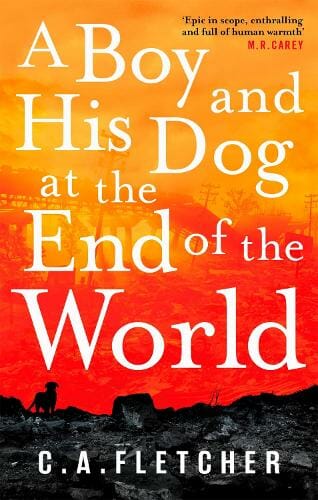If reading is a window to the world, then the following list of the best post-apocalyptic books can be a wide open gateway to the end of times.

The Stand by Stephen King
It is only natural to include The Stand by Stephen King in the list. The world takes a major turn when a plague accidentally finds its way out of a government lab. Within a brief period, almost the entirety of the human population vanishes. Some individuals are apparently immune to the system, and there seems to be a supernatural power behind the resilience. God is present, but unfortunately not the merciful one as everybody expects. It is the almighty angry vengeful Old Testament version. The Stand is both epic and biblical in one thrilling package.

The Road by Cormac McCarthy
It is about a father and son on their way toward the coast, although they have no idea what to do when they get there. IF you’re in for a heavy and hard-thinking read, few are better than The Road, especially as far as post-apocalyptic genre is concerned. The minimalist writing style of Cormac McCarthy is without a doubt an appropriate approach to the nuclear winter theme. However, at times it can get so overly simplistic that you are left wondering what actually happens. It has neither neatly-elaborated explanations about what’s happening nor clear-cut resolutions.

World War Z by Max Brooks
Judging from the author’s background, who used to write for SNL and is the son of a comedian, you might expect World War Z to be something like The Zombie Survival Guide or Brian Slattery’s Liberation; no, it isn’t remotely similar to those. There are no gimmicky, satirical, or picaresque remarks of any sort. What you get here are studious political and socio-economic elucidations with a zombie apocalypse as an unlikely background. All of which are no laughing matters. Despite similarity in title, the book is strikingly different from the movie adaptation. Instead of depicting the world in a struggle for survival, World War Z delivers the thrill of post-apocalyptic scenes in a page-turning documentary style.

Earth Abides by George R. Stewart
There are a few reasons that Earth Abides makes a perfect set along with Stephen King’s The Stand and Cormac McCarthy’s The Road. First, the devastation to the planet and humanity at large happens because of a disease. Stephen King actually found inspiration for The Stand from Earth Abides as well. Second, the book doesn’t place heavy emphasis on the fiction, but more on the impacts of an apocalypse to humanity, so it also feels a bit like The Road. Published in 1949, Earth Abides was among the first of its kind.

I Am Legend by Richard Matheson
Stephen King was inspired by Earth Abides to write The Stand. He also once said that Richard Matheson could be the most influential to him. Like World War Z by Max Brooks, I Am Legend is almost completely different from the movie adaptation. The post-apocalyptic monsters in the book are vampires, rather than zombies. Also, Robert Neville’s loneliness is much more intense and chilling than how the film depicts it. Neville is not one of few remaining humans amidst the apocalypse, he actually is the last human.

A Canticle for Leibowitz by Walter M. Miller, Jr.
The events in A Canticle for Leibowitz are structured in three parts spanning over a period of 1800 years including Fiat Homo, Fiat Lux, and Fiat Voluntas Tua. Each part represents a timeline of six centuries. If the previous books in the list mention zombies, vampires, and disease as the culprits that bring about an apocalypse, A Canticle for Leibowitz cites nuclear warfare and human greed for technology as the roots of the planet’s devastation. Over the course of many centuries, humans are doomed to repeat the same mistakes and send their world to ruins. Messages of anti-science and pro-religion are implied in many places.

One Second After by William R. Forstchen
A terrifying part of One Second After is the realistic premise. The novel sends a cautionary message about how the electromagnetic pulse emitted by nuclear weapons can render all technologies, mainly electronic devices, useless. In a world where the economy and education already depend too much on electric-powered equipment, a malfunction of global scale has all the potential to trigger chaos in the society. While the narration may feel repetitive or preachy, the stories presented are intriguingly captivating and curiosity inducing.

The Passage by Justin Cronin
It has become somewhat difficult not to make a comparison between any vampire novel and Stephanie Meyer’s Twilight. Everybody has personal preferences, but The Passage is objectively different from vampire romance. There is a vampire apocalypse here, but with a slight twist. The creatures are not the typical undead, but a government-engineered type. The story is presented in more than 750 pages, filled with gripping tales and a complex plot. It begins at a time near an apocalypse followed by details of the destruction, and finally enters the aftermath and effects of the disaster.

Hollow Kingdom by Kira Jane Buxton
Many (if not most) post-apocalyptic books or novels give grim tales of the end of the world. People have to fight each other to survive with little to no hope for a better future. Hollow Kingdom makes the otherwise dire situation a little bit brighter because the story is told from the perspective of an optimist. Humans everywhere have been infected by a lethal disease triggered by the use of technology. And you only know that thanks to a domesticated easy-going crow. It is time for the bird and a dog to set out on a journey to solve the problems once and for all. Spoiler alert: Hollow Kingdom is a humorous take on the post-apocalyptic theme.

A Boy and His Dog at the End of the World by Charlie Fletcher
The main character in the novel is a boy named Griz, born in a post-apocalyptic world. He doesn’t have a lot of friends or meet people as often as he wants, simply because there aren’t many people around anymore. It’s a story of survival against loneliness and how to keep those dearest to you as close as possible. As Griz sets on a journey to find his dog, which has been stolen by a thief, the book reveals other characters to add more suspense and intrigues to the boy’s life.

The Book of M by Peng Shepherd
An unsettling apocalypse begins when people no longer have their shadows. It is a bit scary and ridiculous at the same time, but thankfully the corny part ends at the premise. Soon The Book of M explains that losing shadows is like a sudden attack of amnesia, meaning people no longer remember everything about their past. As more characters come to surface, the post-apocalyptic tale quickly takes an exciting form. And so the quest to solve the mystery of disappearing shadows goes full-scale.

Alas, Babylon by Pat Frank
The concepts of holocaust and nuclear weapons are already old-fashioned by today’s standards. However, it doesn’t mean they have lost the chilling effect since the days of the Cold War. Considering that Alas, Babylon was first released in 1959, you’ll be surprised to find that it feels recent. The book has withstood the test of time very well mostly because the story remains relevant to modern day problems. In the wake of an apocalypse, the old values of gender and racial roles are put aside in the struggle for survival. The book delivers the story of hope and dreams for the better future.

Swan Song by Robert McCammon
A blend of fantasy and post-apocalyptic horror is well-crafted into an interesting combination in Swan Song. Similar to The Stand, it features supernatural elements in the battle between good and evil. The book carries an agreeable degree of realism, perhaps even a little too far with the gruesome details of the tragedies. Hopeful and heartbreaking in one package, Swan Song is a long read not for the faint of heart.

The Day of the Triffids by John Wyndham
As far as post-apocalyptic genre is concerned, The Day of the Triffids presents a unique kind of catastrophe. It doesn’t have zombies or nuclear destruction, but a widespread epidemic of sudden blindness caused by a green comet and toxic plants. The novel was first published in 1951 and is a product of the Cold War era, but without all the warfare talk. It’s a book from the old days, so don’t be alarmed when you come across words of blatant bigotry and discrimination overtones. If you can focus on the story itself, it is a rewarding read.

Oryx and Crake by Margaret Atwood
Humanity as we know it has been eradicated, and the world is now under the control of a new race of engineered, much more simplistic humans. The story is told from the perspective of Snowman, the main protagonist and a childhood friend of Crake, the main antagonist. The two of them have relationship with a mysterious woman named Oryx. The book gives thought-provoking ideas about love, friendship, and what it takes to survive in a world deprived of humanity.

Into the Forest by Jean Hegland
Much like One Second After by William R. Forstchen, Into the Forest is terrifying because it feels like a real probability. There are two major themes presented: a post-apocalyptic world without electricity, and the coming-of-age tale of Ava and Nell. Together with their father, the sisters live deep in the forest with no access to technology or medicine. They are cut-off from the society and have to make do with what they have to survive in a harsh new world.

Dhalgren by Samuel R. Delany
A newcomer to the science fiction post-apocalyptic genre might find Dhalgren a bit overwhelming due to the circular nature of the narration and riddle-like story telling. It’s not going to be an easy read, but everyone is welcomed to give it a try. There are mythologies and repeated imagery on an extended trip to a fictional place in an American Midwest. The city has been cut off from the rest of the world because of an unknown disaster. Dhalgren received both high praise and extreme dislike among the sci-fi community. You’ll never know which one to believe until you go through the hallucinatory riddles.
Are you a sci-fi reader? How many of these books have your already read? Let us know if you have some others you like. We’d love to hear from you.
If you liked this, then check out 23 BEST POST-APOCALYPTIC NOVELS AND GRAPHIC NOVELS!
What you may want to know:
What does apocalyptic and post-apocalyptic fiction mean?
According to educalingo.com apocalyptic fiction is a sub-genre of science fiction that is concerned with the end of human civilization. It’s typically due to catastrophes such as nuclear warfare, pandemics, extraterrestrial attack, impact event, cybernetic revolt, technological singularity, dysgenics, supernatural phenomena, divine judgement, runaway climate change, resource depletion, ecological collapse, or some other general disasters. Post-apocalyptic fiction is set in a world after such a disaster. It can happen immediately after the disaster or considerably later. It focuses on the survivors and their trials of surviving.
What is an apocalyptic situation?
Anything related to the total annihilation of the world.
What’s another word for the end of the world?
Apocalyptic, judgement day, Armageddon, day of reckoning, doomsday, day of judgement







